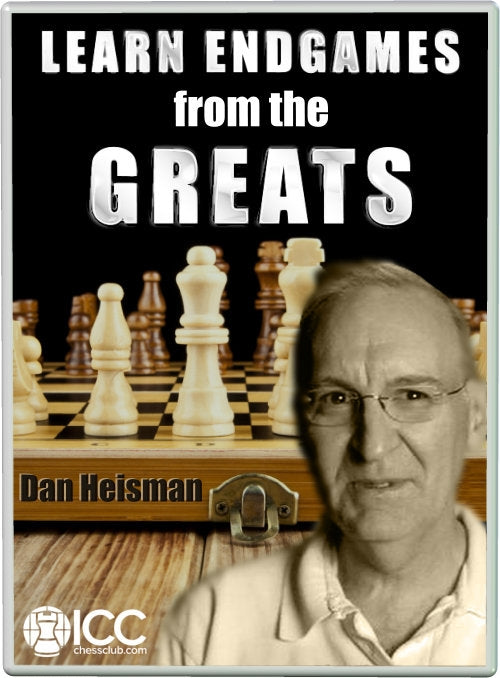ICC chessclub.com
Learn Endgames from the Greats - by Dan Heisman
Learn Endgames from the Greats - by Dan Heisman
Couldn't load pickup availability
Coach Dan Heisman's 'Learn Engames from the Greats - by Dan Heisman'
Learning endgames is not an easy task. It demands long hours spent at the board (or in front of a computer screen), trying to memorize patterns and key positions. On the other hand, every player must know his endgame, if he wants to be successful on the board.
In his new series on endgames, NM Heisman selects games that are decided in the endgame, showing the entire game but focusing on the endgame play. The idea is to present practical, instructive endgames of all types, not just 'theoretical' positions or difficult wins.
Dan researched the most instructive endgames, drawing from the ocean of available material, picking up names like Fischer, Carlsen, Capablanca, Kasparov, Alekhine, Botvinnik, Tartakover, Tchigorin, Lasker, Kramnik, Shirov, Tarrasch. But sometimes even an amateur game can hide a greatly instructive endgame, and on a couple of occasions, Coach Heisman uses amateurs' games in this amazing video series.
These videos are aimed at players with USCF/FIDE ratings in the range of 1100-1900; however, players outside that range may benefit as well.
Here is a short comment for each video:
Video 1 - Damjanovic-Fischer 1970
In the first video of this new series, Coach Dan Heisman shows us a classic: the incredible endgame won by Bobby Fischer over Mato Damjanovic, in the Buenos Aires 1907 Tournament. Fischer scored an impressive 15/18 (with four draws and no losses!). Coach Dan shows us how endgames are not only technique, but rather stamina, resilience and, obviously, knowledge of the game. In this apparently drawn endgame Fischer tries everything in the book to take the point home, succeeding at last. Fischer said: 'You don't know how to win? Well, try stuff!' Does this remind us of someone?
Video 2 - Tchigorin-Tarrash 1905
Tchigorin gets into the bad side of a drawn king and pawn endgame, failing to find the best continuation and losing an instructive position.
Video 3 - Capablanca-Tartakover 1924
A famous endgame where Capablanca gets the 7th rank for his rook then nicely sacrifices two pawns to allow his king to penetrate and create dangerous mate threats.
Video 4 - Pariseau-Heisman 1972
After an exciting opening where White sacrifices a piece, things settle down into an even material endgame with approximately equal chances. Black slowly gains the edge and then forces White to trade into a complicated king and pawn endgame with Black trying to win. Both sides play very slowly (but, as later computer analysis shows, inaccurately) as critical decisions are made on almost every move. Finally, the smoke clears and Black finds a clear win.
Video 5 - Larsen-Kasparov 1983
On his road to the World Championship, Kasparov gets an even endgame vs legend Bent Larsen. Like a modern Carlsen, he continues to poke and probe until Larsen finds himself in a difficult position. Faced with three king moves, Larsen chooses the wrong one and Kasparov weaves a neat mating net.
Video 6 - Lasker-Tarrasch WC1 1908
In the Exchange Variation of the Ruy Lopez, Lasker gets a kingside pawn majority. Tarrasch willingly gives up the bishop pair and ends up defending an inferior, but holdable endgame. After both sides miss chances, Lasker gets enough of an advantage to be decisive with his extra kingside pawn. A textbook example of a healthy majority vs a crippled majority.
Video 7 - Carlsen-Matlakov Tata 2018
A typical Carlsen endgame. As consistent with our series, after an instructive opening, Carlsen goes into an endgame with a slight, but not winning advantage. He slowly gains a little more advantage here and there, making it difficult to pinpoint exactly which move of Black crossed over the threshold from draw to loss. But cross it eventually does and Carlsen, although missing a cute tactic, has plenty enough to drive home the victory.
Video 8 - Kramnik-Shirov Dortmund 1996
Kramnik comes up with an opening novelty in an unbalanced position and Shirov does not find the best answer. Shirov ends up with many pawns vs Kramnik's extra rook, but the pawns are not dangerous. Kramnik gets into the endgame where his two rooks slowly pick up pawn after pawn as Shirov's single rook is no match. Finally, with one pawn vs three, Kramnik uses his extra rook to put Black into zugzwang and Shirov resigns.
Video 9 - Steiner-Alekhine 1921
In the recently 'discovered' Alekhine's Defense (1921), Alekhine gets immediately equality, then eventually goes into an endgame with a slight edge. Despite his claims in 'Alekhine's Best Games', White can hold with proper play. However, as often happens, the inferior side was not played perfectly and Alekhine was able to steadily increase his advantage until it became a winning one. Then some additional nice technique put the game in his win column.
Video 10 - Vallejo Pons-Carlsen Sao Paulo 2012
Carlsen offers a queen trade at the start of the opening, forfeiting the right to castle. Vallejo Pons accepts and an equal queenless middlegame results. In a position which looks like Vallejo Pons might have a slight advantage, the computer rates the chances as equal. Carlsen slowly outplays Vallejo Pons and gains some winning chances. Finally, Vallejo Pons prematurely offers a trade of rooks and the resultant bishop vs knight endgame is won for Carlsen, which he shows with his normally outstanding technique.
Video 11 - Fischer-Bisguier 1959
The young Fischer uncharacteristically forces the trade of queens in the opening. It then becomes a fairly even game all the way into an equal rook and pawn endgame. Bisguier then strangely offers the trade of rooks into a drawn, but dangerously tricky king and pawn endgame where Black has to tread a fine line to draw. Bisguier does just that - for a while - but finally makes that 'easy' fatal mistake and Fischer displays excellent technique (he was only 16 after all) to put the older GM away.
Video 12 - Capablanca-Ed Lasker 1913
In a simul in London Capablanca meets the strong cousin of Emanual, Edward Lasker. Both sides make mistakes during an early tactical duel which leads to a drawn endgame. Ed Lasker trades knights into a tricky king and pawn endgame. Possibly due to the nature of a simul, both sides - yes, even the great Capa - make multiple mistakes in the king and pawn endgame. However, Lasker makes the final mistake and Capablanca wins an instructive ending.
Video 13 - Botvinnik-Alekhine 1938
Alekhine makes an inaccuracy in the opening and Botvinnik obtains the kind of position where only he has play. He trades off into a superior endgame with excellent winning chances. Alekhine continues to have little play and Botvinnik slowly and surely takes advantage of his plusses to build a winning position. Unlike some of the other endgames in this series where the winner was not much ahead going into the endgame, this one is a good example of 'endgame technique' from a winning position.
Video 14 - Yue-Carlsen 2009
In a Rapid (G/30) game, Yue sacrifices the exchange for long-term pressure and the bishop pair. Both sides have difficult decisions to make, but Carlsen's defense finally gives in and Yue gets a winning queen and pawn endgame. Carlsen desperately tries to generate either a mating attack or a perpetual check but Yue's careful handling of the advantage eventually runs Carlsen out of chances and the future World Champion goes down.
Video 15 - Pilnik-Fischer 1959
In a game featured from My 60 Memorable Games and McDonald's Break the Rules, Pilnik plays the opening passively and Fischer easily equalizes and more. Fischer keeps his advantage through a series of exchanges into an endgame with a favorable pawn structure. Fischer and McDonald both discuss Pilnik's chances of saving the game and in this video, the engine Stockfish addresses both commentaries. As with many endgames in this series, eventually, the inferior side has difficulties defending and finally caves in as Fischer wins.
Video 16 - Amateur-Amateur 2018
Two strong amateurs play into a fairly equal endgame where Black has the slightly better chances. Almost immediately White makes an 'aggressive' knight move which backfires. Black soon gets a close-to-winning position where White must defend very carefully. As we have seen repeatedly in this series, this defense is very difficult and, as often occurs, White makes further inaccuracies under pressure and is unable to hold the game.
Video 17 - Capablanca-Dake 1931
Dake blunders a piece in the opening and Capablanca misses it (but then engines are so go...). After a relatively equal middlegame, Capablanca erroneously goes into a lost endgame! Dake then misses a couple of winning lines and instead ends up in a drawn position. To compound his woes, Dake then also misses the drawing opportunity and gives Capa a winning line, which Capablanca finds. All-in-all, a very unexpectedly uneven game full of instructive errors.
Video 18 - Illa-Capablanca 1911
After Capablanca easily equalizes in the opening, he slowly outplays his opponent to get a winning knight endgame. However, he does not play it in the most accurate manner and with an inaccurate 44th move, allows White drawing chances. Another inaccuracy on move 48 leaves the position fully equal. However, there was still play for both sides and White faced a critical but difficult decision on move 52. Unfortunately for Illa, he chose wrong and Capablanca wrapped up the win with good (although unnecessarily cautious) technique.
Video 19 - Heisman-Amateur 1967
Black, the higher rated amateur, plays an erroneous ..h6 in a Richter Rauzer Attack and loses a pawn. White is able to trade into a favorable endgame where both players misplay, each dropping a pawn, but leaving White with an easily winning King and five pawns vs King and four pawns endgame. White displays good technique to wrap up the win.
Run time: 08:44:14


